

Editorial win 05. Body Using circular needle, CO 144[160,180, 200, 216, 236, 260] sts.
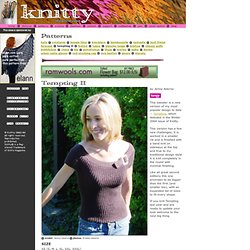
Place marker and join to begin working in the round, being careful not to twist. Work in 1x1 Rib until work measures 13[14, 15, 16, 17, 17, 18] inches. Next Round: Break yarn, place next 12[14, 16, 18, 20, 22, 22] sts on waste yarn; rejoin yarn, work 60[66, 74, 82, 88, 96, 108] sts, break yarn; place next 12[14, 16, 18, 20, 22, 22] sts on waste yarn; rejoin yarn, work 60[66, 74, 82, 88, 96, 108] sts (to end of round). Do not break yarn. Set aside and make sleeves. Knitty.com. Summer 2007. NECK EDGE Using smaller needle, CO 112[130, 148, 166, 186, 202] sts.
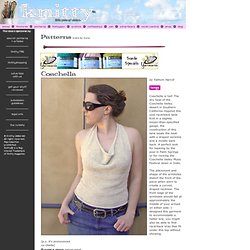
Join to begin working in the round, being careful not to twist. Place marker to indicate end of round (use a marker that is different from the others). Knitty.com. Summerfly. Summertime calls for cute and comfy tops!
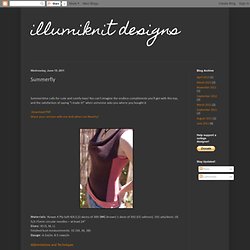
You can't imagine the endless compliments you'll get with this top, and the satisfaction of saying "I made it! " when someone asks you where you bought it. Download PDF Share your version with me and others on Ravelry! Materials: Rowan 4 Ply Soft 4(4,5,5) skeins of 389 (MC-brown) 1 skein of 392 (CC-salmon); 191 yds/skein; US 5/3.75mm circular needles – at least 24” Tank. Shown here in Metallic FX Shown in size Small.

Sizes Directions are for women’s size Small. Changes for sizes Medium, Large and X-Large are in parentheses. Finished Measurements Bust – 38(42-46-52)". Length (Including rolled edge)– 21-1/2(22-22-1/2-23)". Note: When measuring length of this garment, flatten out rolled edge and measure from beg. Walcott. Our empire waisted tank, Wolcott has an interesting construction.

The front and back are each worked from the waist up, then the skirt portions are picked up and worked downward. Shown in size Small Sizes Directions are for women’s size X-Small. Summer 2007. NECK EDGE Using smaller needle, CO 112[130, 148, 166, 186, 202] sts.

Join to begin working in the round, being careful not to twist. Place marker to indicate end of round (use a marker that is different from the others). Round 1: Working into the back of each st, k23[27, 31, 35, 39, 42], place marker, k56[65, 74, 83, 93, 101], place marker, k23[27, 31, 35, 39, 42], place marker, k10[11, 12, 13, 15, 17]. K 4 more rounds, working into the back of each st to create a firm rolled edge. Chalice Lace Tanktop. In celebration of my first post; free tanktops for all!
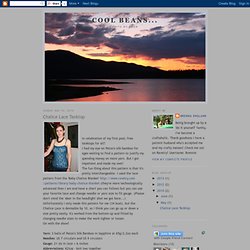
I had my eye on Paton's silk bamboo for ages waiting to find a pattern to justify my spending money on more yarn. But I got impatient and made my own! The fun thing about this pattern is that it's pretty interchangeable. I used the lace pattern from the 'Baby Chalice Blanket' (they're more technologically advanced than I am and have a chart you can follow) but you can use your favorite lace and change needle or yarn size to fit gauge. (Please don't mind the 'deer in the headlight' shot we got here...)Unfortunately I only made this pattern for me (34 bust), but the Chalice Lace is devisable by 10, so I think you can go up or down a size pretty easily. Repeat last 20 rows until work measures 5 inches from cast on edge, change to US 7 needles and continue lace pattern until work measures 13 inches.
Continue in ribbing for 1 inch.Bind off using 'Jeny's surprisingly stretchy bind off' found here: Block your Tank! Wendy Knits. Knitting Increases. An increase is simply adding a stitch to the knitting.
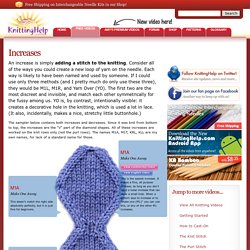
Consider all of the ways you could create a new loop of yarn on the needle. Each way is likely to have been named and used by someone. If I could use only three methods (and I pretty much do only use these three), they would be M1L, M1R, and Yarn Over (YO). The first two are the most discreet and invisible, and match each other symmetrically for the fussy among us. YO is, by contrast, intentionally visible: it creates a decorative hole in the knitting, which is used a lot in lace. The sampler below contains both increases and decreases. Make One Away This doesn't match the right side absolutely perfectly, but it is just fine for beginners. view continental videoview english video.
ABCs of Knitting - Basic Stitches(Increase) Heels by Number. Heels by number Disclaimer: I have not personally turned each of these heels using the number of stitches indicated, but the numbers should work.
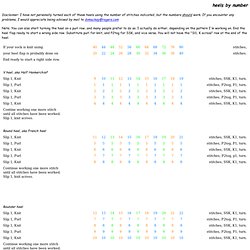
If you encounter any problems, I would appreciate being advised by mail to dvmackay@rogers.com Note: You can also start turning the heel on a purl row, and many people prefer to do so. I actually do either, depending on the pattern I'm working on. End the heel flap ready to start a wrong side row. The math involved in these heels is not hard once you understand how the heel is shaped: Ravelry - a knit and crochet community. Judy's Magic Cast-On. You have cast one stitch on to needle #1. 5.
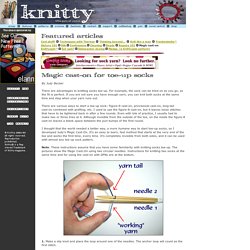
Bring needle #2 over the yarn tail on your thumb, around and under the yarn and back up, making a loop around needle #2. Pull the loop snug around the needle. You have cast one stitch on to needle #2. There are now two stitches on needle #2 Ñ the stitch you just cast on plus the anchor loop. The top yarn strand always wraps around needle #1 (the bottom needle), and the bottom yarn strand always wraps around needle #2 (the top needle). 6. 7. 8.